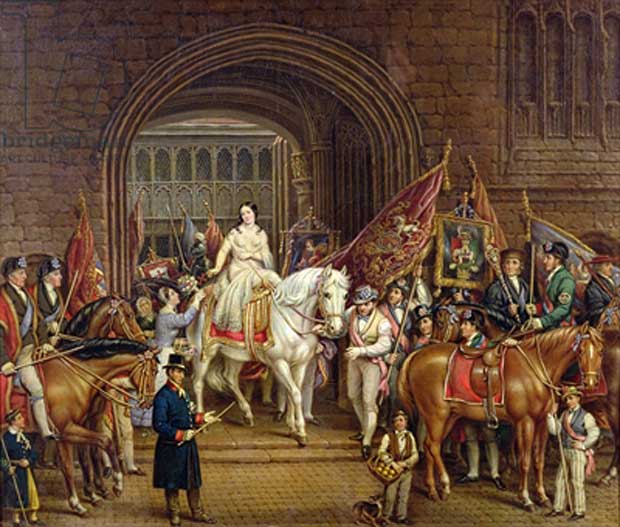THE story of Lady Godiva and her decision to ride naked through the streets of Coventry is one of Britain’s oldest legends, dating back to the Anglo-Saxon period just before the Norman Conquest in 1066.
It has various forms, but the basic story remains the same...
1054: The story of Lady Godiva and her decision to ride naked through the streets of Coventry is one of Britain’s oldest legends
by Hold Ye Front Page
7th October 2016
The Sun
THE story of Lady Godiva and her decision to ride naked through the streets of Coventry is one of Britain’s oldest legends, dating back to the Anglo-Saxon period just before the Norman Conquest in 1066.
It has various forms, but the basic story remains the same.

The aristocrat Lady Godiva was appalled at the high taxes her husband Leofric, Earl of Mercia, was demanding from the people of Coventry. She begged him to spare them.
He refused. But she kept on pleading until her exasperated husband said he would abolish the taxes if she agreed to ride a horse through the streets naked.

Artist’s impression of Lady Godiva’s horse being led through the streets of Coventry by a serving woman
She agreed, after first ordering that the city’s inhabitants stay indoors and keep their windows shuttered during the ride so they could not see her.
The day came, and she rode through the town with her long hair artfully arranged to cover her nakedness as far as possible.
According to legend, a tailor named Tom could not resist taking a peep and bored a hole in his wooden shutters. He is said to have been struck blind by God for his treachery. And voyeurs are often nicknamed Peeping Tom because of the legend.
Godiva’s husband is said to have kept his word and abolished the taxes.
The earliest known versions of the tale do not include either the Peeping Tom section or the order that the citizens must not watch the ride. Indeed, one says Lady Godiva rode naked through Coventry market watched by a crowd.

An early 19th Century painting showing a clothed Lady Godiva at the centre of a procession

King Edward the Confessor and Earl Leofric of Mercia see the face of Christ appear in the Eucharist wafer
Godiva was a common women’s name during the Anglo-Saxon period – meaning "God’s gift."
Leofric’s Anglo-Saxon kingdom, Mercia, stretched across the Midlands. He and Godiva were devout Christians who gave money and land to abbeys and monasteries.
Godiva is also known to have given expensive gifts to Coventry, then a relatively small town.
Leofric died in 1057 and Godiva is known to have carried on as a major landowner. Her lands are mentioned in the Domesday Book, the register of English property commissioned by William the Conqueror after the Norman Invasion.
It is believed Godiva died sometime between 1066 and 1086.
While there is plenty of evidence for the existence of Godiva, there is nothing firm to suggest the legend is true.
In fact Godiva, after her husband’s death, may herself have been responsible for the collection of tax in Coventry.
Hereward The Wake
HEREWARD the Wake was an 11th Century rebel who waged a guerrilla war against the Norman conquerors in the years after the Battle of Hastings.
His forces were based in the Fens area of Cambridgeshire, Lincolnshire and Norfolk – then a sizeable area of marsh and dense woodland where the heavily-armoured Norman cavalry found it difficult to operate.
In his lifetime Hereward was referred to as Hereward the Outlaw. The title Wake, which means The Watchful or The Wary, was not used until many years after his death.

Engraving showing one possible end for Hereward, killed by Normans with only a shield to defend himself
There are various legends about his life – some of them clearly fictitious. But he was almost certainly of noble birth and owned land throughout the Fens. It is possible he was related to Lady Godiva and her husband Leofric.
Indeed a popular tradition says he was their son, although there is no solid evidence for this. Some modern historians believe he was of Viking descent.
Hereward seems to have been a troublemaker who was a thorn in the side of the Anglo Saxon authorities well before the Norman invasion. Some accounts claim he was sent into exile in either Scotland or Flanders in 1054 when he was 18.
Another legend says he was declared an outlaw by Anglo Saxon king Edward the Confessor over a feud with his father.
He is known to have fought as a mercenary abroad and may have been out of the country when William landed in 1066. One tradition says he returned to lead a resistance campaign after the Normans seized his family’s lands.
In 1070 he was among the leaders of a war party that raided Peterborough Abbey, allegedly to preserve its treasures and holy relics from the Normans.
The next year Norman soldiers stormed his Fens stronghold on the Isle of Ely. They suffered heavy casualties and failed to catch Hereward, who continued his resistance campaign.
Hereward is said to have died in 1071 or 1072, although accounts of his death differ. One says he was pardoned by William and became a law-abiding landowner. Another claims he was killed by Norman soldiers after being lured to peace talks. A third says he went into exile.
https://www.thesun.co.uk/news/hold-...f-coventry-is-one-of-britains-oldest-legends/
It has various forms, but the basic story remains the same...
1054: The story of Lady Godiva and her decision to ride naked through the streets of Coventry is one of Britain’s oldest legends
by Hold Ye Front Page
7th October 2016
The Sun
THE story of Lady Godiva and her decision to ride naked through the streets of Coventry is one of Britain’s oldest legends, dating back to the Anglo-Saxon period just before the Norman Conquest in 1066.
It has various forms, but the basic story remains the same.

The aristocrat Lady Godiva was appalled at the high taxes her husband Leofric, Earl of Mercia, was demanding from the people of Coventry. She begged him to spare them.
He refused. But she kept on pleading until her exasperated husband said he would abolish the taxes if she agreed to ride a horse through the streets naked.

Artist’s impression of Lady Godiva’s horse being led through the streets of Coventry by a serving woman
She agreed, after first ordering that the city’s inhabitants stay indoors and keep their windows shuttered during the ride so they could not see her.
The day came, and she rode through the town with her long hair artfully arranged to cover her nakedness as far as possible.
According to legend, a tailor named Tom could not resist taking a peep and bored a hole in his wooden shutters. He is said to have been struck blind by God for his treachery. And voyeurs are often nicknamed Peeping Tom because of the legend.
Godiva’s husband is said to have kept his word and abolished the taxes.
The earliest known versions of the tale do not include either the Peeping Tom section or the order that the citizens must not watch the ride. Indeed, one says Lady Godiva rode naked through Coventry market watched by a crowd.

An early 19th Century painting showing a clothed Lady Godiva at the centre of a procession

King Edward the Confessor and Earl Leofric of Mercia see the face of Christ appear in the Eucharist wafer
Godiva was a common women’s name during the Anglo-Saxon period – meaning "God’s gift."
Leofric’s Anglo-Saxon kingdom, Mercia, stretched across the Midlands. He and Godiva were devout Christians who gave money and land to abbeys and monasteries.
Godiva is also known to have given expensive gifts to Coventry, then a relatively small town.
Leofric died in 1057 and Godiva is known to have carried on as a major landowner. Her lands are mentioned in the Domesday Book, the register of English property commissioned by William the Conqueror after the Norman Invasion.
It is believed Godiva died sometime between 1066 and 1086.
While there is plenty of evidence for the existence of Godiva, there is nothing firm to suggest the legend is true.
In fact Godiva, after her husband’s death, may herself have been responsible for the collection of tax in Coventry.
Hereward The Wake
HEREWARD the Wake was an 11th Century rebel who waged a guerrilla war against the Norman conquerors in the years after the Battle of Hastings.
His forces were based in the Fens area of Cambridgeshire, Lincolnshire and Norfolk – then a sizeable area of marsh and dense woodland where the heavily-armoured Norman cavalry found it difficult to operate.
In his lifetime Hereward was referred to as Hereward the Outlaw. The title Wake, which means The Watchful or The Wary, was not used until many years after his death.

Engraving showing one possible end for Hereward, killed by Normans with only a shield to defend himself
There are various legends about his life – some of them clearly fictitious. But he was almost certainly of noble birth and owned land throughout the Fens. It is possible he was related to Lady Godiva and her husband Leofric.
Indeed a popular tradition says he was their son, although there is no solid evidence for this. Some modern historians believe he was of Viking descent.
Hereward seems to have been a troublemaker who was a thorn in the side of the Anglo Saxon authorities well before the Norman invasion. Some accounts claim he was sent into exile in either Scotland or Flanders in 1054 when he was 18.
Another legend says he was declared an outlaw by Anglo Saxon king Edward the Confessor over a feud with his father.
He is known to have fought as a mercenary abroad and may have been out of the country when William landed in 1066. One tradition says he returned to lead a resistance campaign after the Normans seized his family’s lands.
In 1070 he was among the leaders of a war party that raided Peterborough Abbey, allegedly to preserve its treasures and holy relics from the Normans.
The next year Norman soldiers stormed his Fens stronghold on the Isle of Ely. They suffered heavy casualties and failed to catch Hereward, who continued his resistance campaign.
Hereward is said to have died in 1071 or 1072, although accounts of his death differ. One says he was pardoned by William and became a law-abiding landowner. Another claims he was killed by Norman soldiers after being lured to peace talks. A third says he went into exile.
https://www.thesun.co.uk/news/hold-...f-coventry-is-one-of-britains-oldest-legends/
Last edited:
